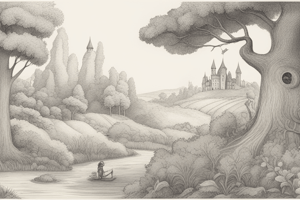Podcast
Questions and Answers
What creates a vacuum in the chest cavity to allow air to move into the lungs?
What creates a vacuum in the chest cavity to allow air to move into the lungs?
- Pleura
- Capillaries
- Alveoli
- Diaphragm and intercostal muscles (correct)
What is the primary function of the lungs?
What is the primary function of the lungs?
- To digest food
- To regulate body temperature
- To pump blood to the heart
- To deliver oxygen to the bloodstream and remove carbon dioxide (correct)
Which structure in the lungs is surrounded by a network of capillaries for gas exchange?
Which structure in the lungs is surrounded by a network of capillaries for gas exchange?
- Pleura
- Alveoli (correct)
- Bronchi
- Intercostal muscles
In what direction does oxygen move during gas exchange in the lungs?
In what direction does oxygen move during gas exchange in the lungs?
What is the function of the pleura in the respiratory system?
What is the function of the pleura in the respiratory system?
Why does the right lung have a slightly larger, more triangular shape compared to the left lung?
Why does the right lung have a slightly larger, more triangular shape compared to the left lung?
What is the process through which oxygen moves between the alveoli and the capillaries?
What is the process through which oxygen moves between the alveoli and the capillaries?
Which lung capacity represents the additional air that can be inhaled beyond the tidal volume?
Which lung capacity represents the additional air that can be inhaled beyond the tidal volume?
What is the primary factor that impairs lung function, according to the text?
What is the primary factor that impairs lung function, according to the text?
Which capacity is calculated by summing up the tidal volume, inspiratory reserve volume, and expiratory reserve volume?
Which capacity is calculated by summing up the tidal volume, inspiratory reserve volume, and expiratory reserve volume?
What is the mechanism by which carbon dioxide moves out of the bloodstream into the alveoli?
What is the mechanism by which carbon dioxide moves out of the bloodstream into the alveoli?
Which action is NOT listed as a way to promote lung health in the text?
Which action is NOT listed as a way to promote lung health in the text?
Flashcards are hidden until you start studying
Study Notes
Unraveling the Complexity of Lungs
The lungs, two spongy, cone-shaped organs nestled within our ribcage, are a vital part of our respiratory system. They play a critical role in the process of breathing, serving as our interface with the air we need to live. In this article, we'll explore the structure, function, and some of the key elements that make these organs so intricate and important.
Lung Anatomy
The lungs are enclosed within the ribcage, with the right lung having a slightly larger, more triangular shape due to the positioning of the heart. They are protected by the ribs and the breastbone, the pleura (a thin membrane), and are filled with air sacs called alveoli. The alveoli are surrounded by a network of capillaries, creating a large surface area for gas exchange.
Lung Function
The primary function of the lungs is to deliver oxygen to the bloodstream and remove carbon dioxide, a waste product of cellular respiration. When we breathe in, the diaphragm and intercostal muscles contract, creating a vacuum in the chest cavity, allowing air to move into the lungs. As air flows through the respiratory tract, it travels into smaller and smaller passageways, ultimately reaching the alveoli. Oxygen in the air diffuses through the thin walls of the alveoli and into the bloodstream, while carbon dioxide moves in the opposite direction, leaving the lungs.
Gas Exchange
The process of gas exchange is facilitated by the close proximity of the alveoli and capillaries. Oxygen moves across the thin membrane between the alveoli and the capillaries, either by diffusion or by the action of the protein, oxygen-hemoglobin. Carbon dioxide, on the other hand, moves out of the bloodstream into the alveoli by the process of passive diffusion, where it is then expelled from the body when we exhale.
Lung Capacity
The lungs have three main capacities: tidal volume, inspiratory reserve volume, and expiratory reserve volume.
- Tidal volume is the amount of air that enters and leaves the lungs during normal breathing.
- Inspiratory reserve volume is the additional amount of air that can be inhaled beyond the tidal volume.
- Expiratory reserve volume is the extra air that can be expelled from the lungs after a normal exhale.
The sum of tidal volume, inspiratory reserve volume, and expiratory reserve volume is called the vital capacity, which is approximately 4-6 liters in adults.
Lung Health
To maintain optimal lung function, it's essential to protect the lungs from damage. Smoking, air pollution, and other environmental factors are known to impair lung function. Promoting lung health through regular exercise, avoiding cigarette smoke, wearing a mask when needed, and receiving recommended vaccinations can help keep the lungs healthy and functioning at their best.
In summary, the lungs are a fascinating and essential part of the human body, serving as our primary interface with the air we need to survive. Understanding their structure, function, and the key elements that make them work so well is essential for maintaining our overall health and well-being.
Studying That Suits You
Use AI to generate personalized quizzes and flashcards to suit your learning preferences.




